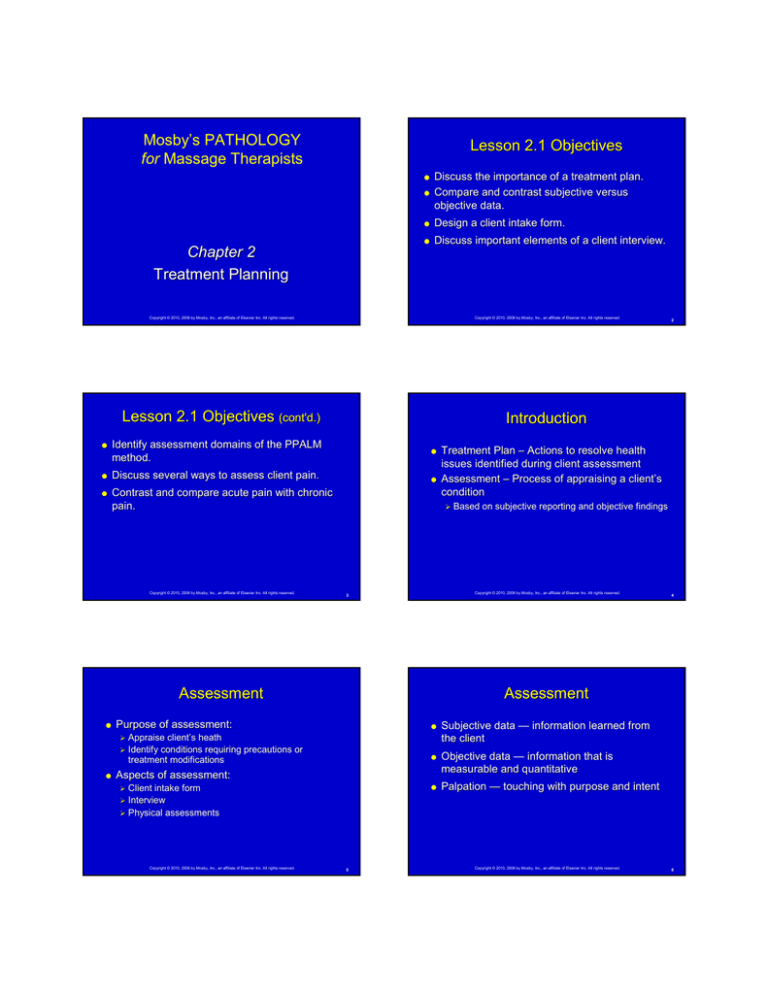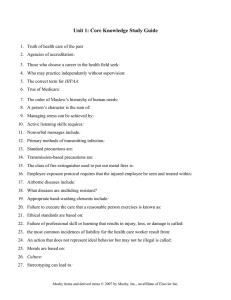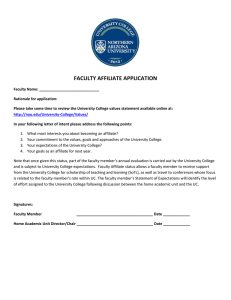
Mosby’s PATHOLOGY
for Massage Therapists
Lesson 2.1 Objectives
Discuss the importance of a treatment plan.
Compare and contrast subjective versus
objective data.
Design a client intake form.
Discuss important elements of a client interview.
Chapter 2
Treatment Planning
Copyright © 2010, 2006 by Mosby, Inc., an affiliate of Elsevier Inc. All rights reserved.
Copyright © 2010, 2006 by Mosby, Inc., an affiliate of Elsevier Inc. All rights reserved.
Lesson 2.1 Objectives (cont'd.)
Introduction
Identify assessment domains of the PPALM
method.
Discuss several ways to assess client pain.
Contrast and compare acute pain with chronic
pain.
Copyright © 2010, 2006 by Mosby, Inc., an affiliate of Elsevier Inc. All rights reserved.
4
Assessment
Purpose of assessment:
Appraise client’
client’s heath
Identify conditions requiring precautions or
treatment modifications
Subjective data — information learned from
the client
Objective data — information that is
measurable and quantitative
Palpation — touching with purpose and intent
Based on subjective reporting and objective findings
Copyright © 2010, 2006 by Mosby, Inc., an affiliate of Elsevier Inc. All rights reserved.
Assessment
Treatment Plan – Actions to resolve health
issues identified during client assessment
Assessment – Process of appraising a client’
client’s
condition
3
2
Aspects of assessment:
Client intake form
Interview
Physical assessments
Copyright © 2010, 2006 by Mosby, Inc., an affiliate of Elsevier Inc. All rights reserved.
5
Copyright © 2010, 2006 by Mosby, Inc., an affiliate of Elsevier Inc. All rights reserved.
6
Client Intake Form
Personal and contact information
Health and medical information
Emergency contact person
Regular physician or health care provider
Date the information is recorded
Copyright © 2010, 2006 by Mosby, Inc., an affiliate of Elsevier Inc. All rights reserved.
Client Intake Form (cont’
(cont’d.)
Copyright © 2010, 2006 by Mosby, Inc., an affiliate of Elsevier Inc. All rights reserved.
7
Interview
Client Intake Form (cont’
(cont’d.)
Presenting the intake form:
Purpose of interview:
Helps the therapist screen for contraindications or
realize the need for adaptive measures
Gives the therapist a chance to gather details needed
to provide better service, such as
• Primary purpose for session
• Client’
Client’s personal preferences
Greet client
Escort client to a quiet area with adequate lighting
Present form, clipboard, and writing pen
Obtain important forms (prescriptions, referrals,
clearance)
Obtain client signature
Copyright © 2010, 2006 by Mosby, Inc., an affiliate of Elsevier Inc. All rights reserved.
Copyright © 2010, 2006 by Mosby, Inc., an affiliate of Elsevier Inc. All rights reserved.
9
Interview (cont’
(cont’d.)
8
10
Interview
Interview process:
Greet client by name
Introduce yourself
Review information on intake
form
Be sure form is complete,
dated, and signed
Organize interview; highlight
health and individual issues
(e.g. PPALM method)
Conclude interview
Sit facing the client at eye level
Begin with a brief orientation
Use openopen- and closedclosed-ended questions
OpenOpen-ended questions offer little restriction when
answering
CloseClose-ended questions require a “yes”
yes” or “no”
no”
response
From Salvo S: Massage therapy: principles and practice, ed. 2, Philadelphia, 2003, Saunders.
Copyright © 2010, 2006 by Mosby, Inc., an affiliate of Elsevier Inc. All rights reserved.
11
Copyright © 2010, 2006 by Mosby, Inc., an affiliate of Elsevier Inc. All rights reserved.
12
Interview
Listen carefully and use reflective questions
Take notes sparingly
Use silence
PPALM
PPALM stands for the first letter of five
assessment domains
This gives client time to talk, giving therapist
greater understanding of client
Signal your interest
From Salvo S: Massage therapy: principles and practice, ed. 3, St. Louis, 2007, Saunders.
Copyright © 2010, 2006 by Mosby, Inc., an affiliate of Elsevier Inc. All rights reserved.
Copyright © 2010, 2006 by Mosby, Inc., an affiliate of Elsevier Inc. All rights reserved.
13
PPALM (cont’
(cont’d.)
PPALM (cont’
(cont’d.)
Five steps of treatment planning:
PPALM
Purpose of session
Identify client’
client’s reason for session
Discuss client’
client’s past experience with massage
therapy
If client is a minor, obtain permission from:
• Child’
Child’s parent or
• Child’
Child’s legal guardian
Ask client questions using the PPALM format
Collect data
Appraise and synthesize data; integrate data with
one’
one’s own clinical expertise
Discuss plan with client
Implement plan
Copyright © 2010, 2006 by Mosby, Inc., an affiliate of Elsevier Inc. All rights reserved.
14
Copyright © 2010, 2006 by Mosby, Inc., an affiliate of Elsevier Inc. All rights reserved.
15
16
PPALM (cont’
(cont’d.)
(cont’
(cont’d.)
Assess pain using OPPQRST and pain
scales
Pain
Ask about pain
Is it related to injury or illness?
How is it being treated?
Pain can be acute (began abruptly) or chronic
(developed slowly)
Fig. 22-4 from Salvo SG: Massage therapy: principles and practice, ed 3, 2007, St. Louis, Saunders;
Fig. 22-5 from Hockenberry MJ: Wong’
Wong’s nursing care of infants and children, ed 8, 2007, St. Louis, Mosby.
Copyright © 2010, 2006 by Mosby, Inc., an affiliate of Elsevier Inc. All rights reserved.
17
Copyright © 2010, 2006 by Mosby, Inc., an affiliate of Elsevier Inc. All rights reserved.
18
PPALM (cont’
(cont’d.)
PPALM (cont’
(cont’d.)
Allergies and skin conditions
Inquire about the client’
client’s heath status
If a disease is present, ask how long the client has had
the condition, how it is managed, current symptoms,
and any activity limitations
If a client’
client’s symptoms are unstable, obtain medical
clearance before massage
Ask about medication use and their purpose
Lifestyle and vocation
Factors include occupation, leisure or sports activities,
physical exercise, stress level, and nutrition
Copyright © 2010, 2006 by Mosby, Inc., an affiliate of Elsevier Inc. All rights reserved.
Medical history
Inquire about allergies to ingredients in massage
lubricants
Use hypoallergenic products when needed
Ask client about skin conditions
Copyright © 2010, 2006 by Mosby, Inc., an affiliate of Elsevier Inc. All rights reserved.
19
Screening Clients for
Contraindications
Lesson 2.2 Objectives
Describe the importance of screening clients for
contraindications.
List items included in a treatment plan.
Discuss postmassage communication.
Design treatment plans for subsequent sessions.
Copyright © 2010, 2006 by Mosby, Inc., an affiliate of Elsevier Inc. All rights reserved.
Elevating the upper body or avoiding an area
Reducing pressure or session time
Sometimes, massage is postponed
Copyright © 2010, 2006 by Mosby, Inc., an affiliate of Elsevier Inc. All rights reserved.
21
22
Formulating a Treatment Plan
Contraindication – Presence of disease or
condition so a particular client cannot be
treated in the usual manner
Based on:
Client health intake form
Interview
Other assessments, such as soft tissue palpation
Absolute – Massage is inappropriate, not advised,
and may be harmful
Local – Massage can be administered while
avoiding infected/inflamed area or area in question
Copyright © 2010, 2006 by Mosby, Inc., an affiliate of Elsevier Inc. All rights reserved.
Ruling out contraindications is our duty and
obligation
Most conditions require only slight adjustments
Contraindications (cont’
(cont’d.)
20
23
Take into account a client’
client’s financial and time
restraints
Copyright © 2010, 2006 by Mosby, Inc., an affiliate of Elsevier Inc. All rights reserved.
24
Formulating a Treatment Plan
Formulating a Treatment Plan
(cont’
(cont’d.)
(cont’
(cont’d.)
Includes:
Techniques and areas to include or avoid
Recommendations for selfself-care
Duration, frequency, and length of treatments
Reassessment
Referrals
Copyright © 2010, 2006 by Mosby, Inc., an affiliate of Elsevier Inc. All rights reserved.
Includes (cont’
(cont’d.):
Whether client needs assistance
Use of special support or bolstering devices
Use of adjunctive therapies
Suggested reading material
Copyright © 2010, 2006 by Mosby, Inc., an affiliate of Elsevier Inc. All rights reserved.
25
Communication After Treatment
Subsequent Sessions
Client evaluation of massage
Review PPALM notes
Ask client to evaluate massage
Modify plan for future sessions if needed
Update plan based on progress toward client’
client’s
goals
Discuss client education and homework
assignments
Copyright © 2010, 2006 by Mosby, Inc., an affiliate of Elsevier Inc. All rights reserved.
26
27
In general, the initial treatment period consists of
frequent sessions, tapering off as symptoms subside
Ask about symptoms and tailor treatment based
on client symptoms that day
Copyright © 2010, 2006 by Mosby, Inc., an affiliate of Elsevier Inc. All rights reserved.
28






